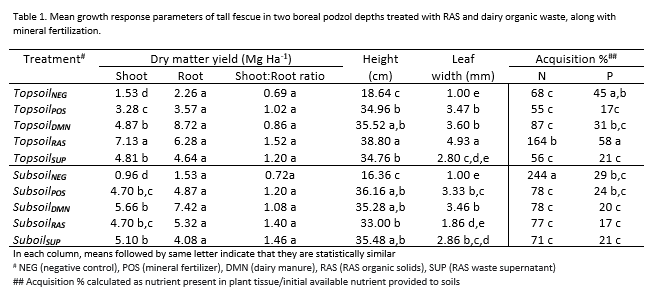RECIRCULATING AQUACULTURE SYSTEM ORGANIC WASTE UTILIZATION IN BOREAL PODZOLIC AGRICULTURE INTENSIFICATION, AN OPPORTUNITY FOR SUSTAINABLE NUTRIENT MANAGEMENT
Simultaneous expansion of aquaculture and agriculture in Newfoundland and Labrador (NL) creates opportunities for integrated waste stream utilization. Agriculture expansion in NL involves the land use conversion (LUC) of boreal podzols. Podzols offer a distinct layering of chemical properties with agronomic potential decreasing with soil depth. Utilizing aquaculture organic waste could be an effective way of capturing resources while enhancing agriculture activity on boreal podzols. To explore the agricultural use of recirculating aquaculture system (RAS) organic waste a study was conducted at the Centre for Agriculture and Forestry Development. The study was a 12 week greenhouse pot experiment in a completely randomized block design. Treatment factors included organic and mineral fertiliser application to topsoil (0-15cm) and subsoil (15-30cm) collected from a white spruce (Pinus strobus) plantation. The utility of RAS organic solids and supernatant were compared against dairy manure and also against mineral fertilizer as positive controls. Tall fescue (Festuca arundinacea) a regionally common forage was the test crop and was fertilized at rates equivalent to 200 kg/ha of N and 110 kg/ha of P. Agronomic performance was measured as growth rate, biomass accumulation, and nutrient acquisition (Table 1). While initial growth rates were accelerated for the subsoil treatments they were not sustained through the length of the experiment, a behaviour distinct from the topsoil. Topsoil treatments where slower but consistent growth was maintained for the entire experiment. This suggests variable nutrient retention and availability between soil depths. Final yields for the same fertilizers where generally comparable between soil layers except for the RAS treatments. The distinctly higher productivity with RAS in the topsoil was not matched in the subsoil. Furthermore, RAS amended subsoils led to a reduced plant P acquisition, an indication of the subsoils’ capacity to retain P. This highlights the impact that the interaction between soil layer and fertilizer type had on the nutrient availability profiles. When aware of the nature of the soil, organic waste from RAS could be a sustainable nutrient source in the agriculture sector.
